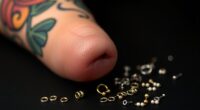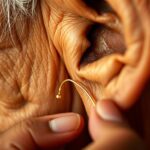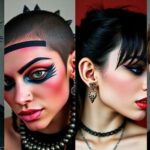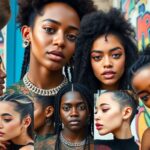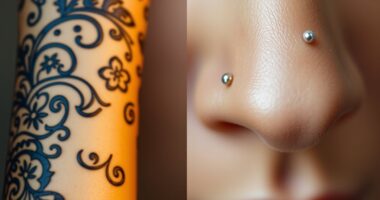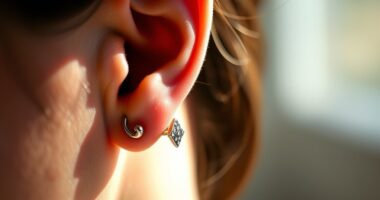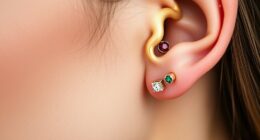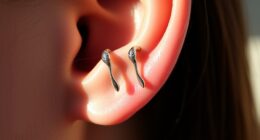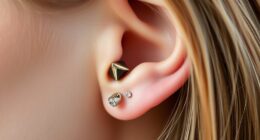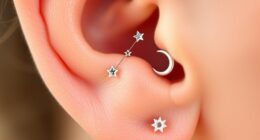Piercings have become mainstream by evolving from ancient symbols of status, spirituality, and rites of passage into a form of personal expression that society now embraces. Over recent decades, cultural shifts, social media, and celebrity influence have helped normalize piercings, transforming them from subcultural symbols into everyday fashion statements. This change reflects broader acceptance of individuality and diversity. If you keep exploring, you’ll discover how this progression shaped modern attitudes toward body modifications and self-expression.
Key Takeaways
- Ancient civilizations used piercings to signify social status and spiritual milestones, establishing their cultural significance.
- Societal attitudes shifted from subcultural symbols to accepted fashion statements due to increased acceptance and self-expression.
- Celebrities and media exposure popularized piercings, normalizing them as mainstream beauty and style choices.
- High fashion and art scenes incorporated piercings, blending body modification with contemporary aesthetics.
- Broader cultural shifts toward diversity and individuality fostered societal acceptance of piercings as personal art and identity expressions.
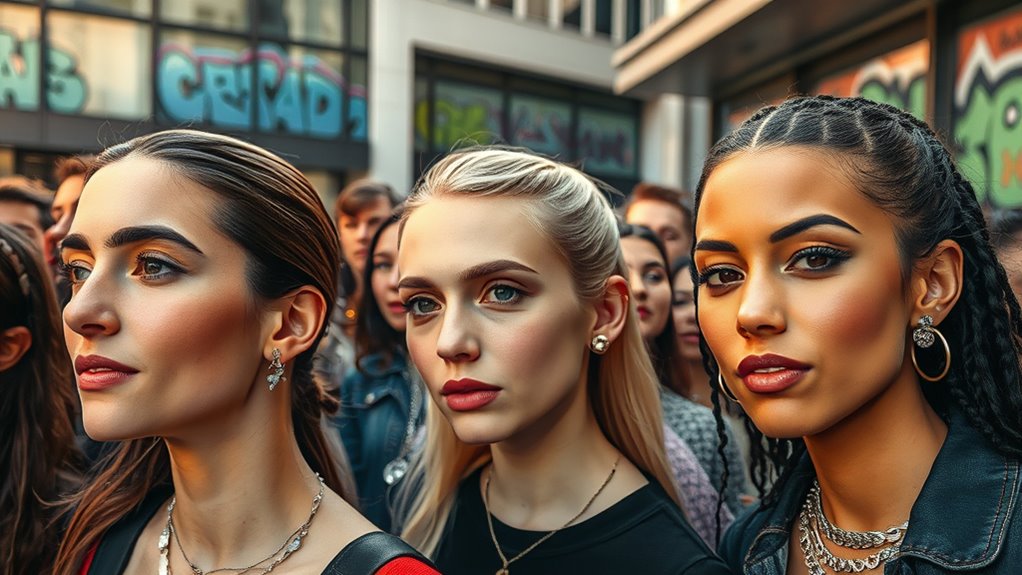
Piercings have increasingly become a mainstream cultural trend, transforming from symbols of rebellion or subcultural identity into widely accepted forms of personal expression. Over time, society’s view of body modifications has shifted dramatically, influenced by changing attitudes toward individual autonomy and aesthetic diversity. Historically, piercing practices can be traced back thousands of years across various civilizations, where they held deep cultural and spiritual significance. In ancient Egypt, for example, piercings were symbols of status and religious devotion. Similarly, tribes in Africa and indigenous peoples across the Pacific used piercings to mark rites of passage, social rank, or spiritual milestones. These historical practices laid the groundwork for modern acceptance, revealing that piercing has long been intertwined with cultural identity and personal meaning. It wasn’t until recent decades that these traditions began to influence mainstream fashion and individual self-expression. Additionally, the growing influence of social media and celebrity culture has played a significant role in normalizing piercings as an accessible form of personal expression.
Today, piercing is not just about cultural or spiritual significance; it’s also a recognized form of artistic expression. You might see a simple earlobe piercing or more elaborate designs like cartilage, septum, or facial piercings—all serving as a canvas for personal creativity. Artists and body piercers have elevated their craft into a form of visual art, transforming the body into a living sculpture. This shift toward artistic expression is what helps piercings to be seen as more than mere adornment—they become statements of personality, identity, or even political stance. Many people choose piercings to challenge societal norms or to celebrate individuality, and the skill of professional piercers ensures that these modifications are both safe and uniquely customized. As piercing culture evolves, it’s increasingly integrated into fashion trends, pop culture, and art scenes, further normalizing it and breaking down previous stigmas.
The acceptance of piercings in mainstream society is also a reflection of broader cultural shifts toward embracing diversity and nonconformity. What was once confined to subcultures like punk, goth, or alternative scenes now influences high fashion runways and celebrity aesthetics. Celebrities sporting visible piercings on social media and in movies help normalize the practice, making it more accessible and acceptable for everyone. You’re now more likely to see piercings as an everyday expression of style rather than a rebellious act. This cultural evolution underscores how piercings have grown from historical artifacts into a form of personal art that celebrates individuality while reflecting society’s increasing openness to diverse forms of self-representation.
Frequently Asked Questions
How Did Ancient Cultures Influence Modern Piercing Trends?
Ancient cultures influence your modern piercing trends through their use of ancient symbolism and cultural rituals. You can see this in tribal nose and ear piercings, which historically signified social status, spiritual beliefs, or rites of passage. These traditions have been passed down, inspiring contemporary styles that honor their origins. By embracing these symbols and rituals, you connect with a rich cultural history while expressing your individuality through piercing choices.
What Role Did Celebrities Play in Popularizing Piercings?
Celebrity influence skyrocketed piercings into global fame, turning them into must-have fashion trends overnight. When stars flaunt bold nose rings or ear cuffs, millions follow suit, believing it’s the secret to their style success. You can’t ignore their impact—celebrities shape what’s hot and what’s not, making piercings the ultimate statement piece. Their daring looks inspire entire fashion movements, making piercing culture impossible to ignore in today’s trend-driven world.
Are There Regional Differences in Piercing Acceptance Worldwide?
Yes, there are regional variations in piercing acceptance worldwide. You’ll find that cultural acceptance varies greatly, with some regions embracing piercings as part of tradition or fashion, while others may view them more skeptically. In places like Africa, India, and Southeast Asia, piercings often hold cultural or spiritual significance. Conversely, Western countries tend to have more liberal attitudes, making piercings more mainstream and widely accepted across different age groups.
How Has Social Media Impacted Piercing Popularity?
Social media has markedly boosted piercing popularity by showcasing virtual showcases and influencer trends that inspire you to try new styles. When influencers share their piercing journeys or highlight unique jewelry, you feel more confident and motivated to get pierced. This constant exposure creates a sense of community and normalizes piercings, making them accessible and appealing to a broader audience worldwide.
What Are the Health Risks Associated With Mainstream Piercings?
You should be aware that mainstream piercings can carry health risks like infection risks and allergic reactions. If the piercing isn’t done properly or if you don’t keep it clean, bacteria can cause infections. Also, some jewelry materials may trigger allergies, leading to redness, swelling, or irritation. To stay safe, choose reputable piercers, follow aftercare instructions, and opt for hypoallergenic jewelry.
Conclusion
Today, over 36% of people in the US have at least one piercing, showing how it’s become a common form of self-expression. You’ve seen how piercings shifted from rebellion to mainstream fashion, reflecting changing cultural attitudes. As you embrace your own style, remember that piercing trends continue to evolve, blending tradition and individuality. It’s clear that piercings are no longer just about aesthetics—they’re a powerful way to tell your story in a diverse, accepting world.
Piecing together a life one day at a time, that’s me. I’m Rusty, and I love being editor-in-chief of creative piercing. It’s my passion to help others see their vision and bring it to life. When I’m not working or taking care of my family, you can find me reading a good book or eating pie (of course!).


